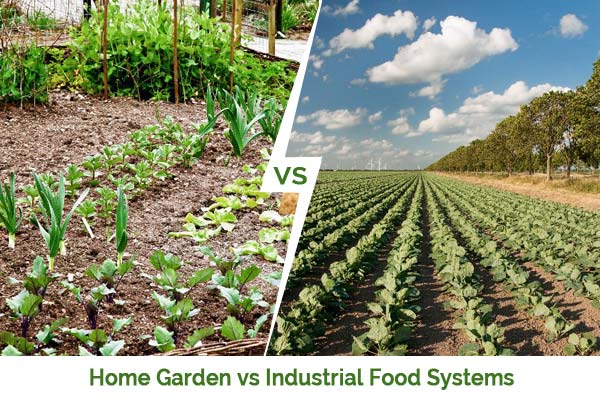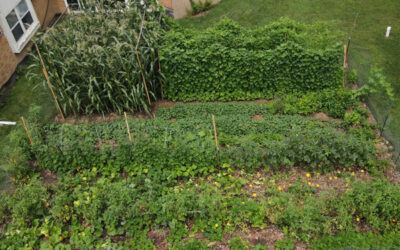- The Garden Food System – IV
- The Garden Food System – III
- The Garden Food System – II
- The Garden Food System – I
Why The Garden and Industrial Food Systems Are So Different
First, just to map out some context, how are the two systems alike?
Well to begin with, as their titles denote, they are both systems. A system is a group of interacting parts that work together as a whole. In addition, both the GFS and the IFS require people to design, set up, and maintain them. They also both make use of the sun, air, earth, and water to produce food, and both can feed millions. If the latter assertion for the GFS comes as a surprise, see why farms aren’t the only means of mass food production.
Otherwise, these two systems have little in common.
The Industrial Food System
The IFS is a business operation whose overarching purpose is to generate financial gain while producing food. It’s a top-down, command-and-control promulgation. Even when there is employee co-ownership there is nearly always a CEO or the like ruling individual companies, and increasingly, cabals of very large corporations that together control the conditions of commerce in their sectors. The IFS ensures its profits on a bell curve sliding scale, with the lion’s share going to giant corporate middlemen, and the least share going to food workers all along the supply chain, from field to retail.
Industrial food generates enormous collateral damage, externalizing $trillions per year in expenses that are paid by other entities in our society. It largely engages in linear one-time use of (non-machine) physical matter, of which little is sustainably recycled or re-used. In addition, it depends heavily on machinery and hard technology (GPS, robotics, AI, “precision” agriculture, blockchain technology, etc.). It has masterfully conditioned customers to value artificially cheap food and short-term convenience at the unsustainable expense of all other considerations, resulting in food-related disconnection of people from the earth, one another, and from themselves.
At a deeper level, the IFS depends on a perception of food scarcity (always trying to increase yields “for a hungry world,”) and the idea that fierce and often unfair competition between companies producing the same commodities is beneficial.
 The Garden Food System
The Garden Food System
The GFS is a different animal altogether, as it’s primarily an ecological rather than a financial operation. Yes, you need to buy seeds, as well as initial gardening and preserving supplies, and the companies supplying those necessities are bona-fide businesses. But otherwise, it’s a mostly cashless system. It features a dispersed (but not “democratic”) modus operandi that doesn’t have a system-wide “purpose” per se. Rather, by virtue of functioning more along the lines of a self-organizing and self-maintaining natural ecosystem, it has the enduring outcome of smooth overall functioning, with much greater resilience to perturbations than the industrial system. Other than possibly some businesses providing the same supplies (and not necessarily even those), no components are consciously competing with one another in zero-sum games (i.e., with some companies or corporate power blocks winning at the existential expense of other, less powerful entities).
As a result, the GFS intrinsically avoids collateral damage, internalizes its expenses, and (fully developed) recycles and/or re-uses indefinitely all physical matter (see below). It relies mostly on soft-tech and natural intelligence (NI) rather than hard tech. For the purposes of this discussion, NI refers to non-mechanistic, mostly ecologically informed rather than machine-generated intelligence (AI) set up to operate outside of the principles guiding wild ecosystems. Thus, the human parameters of NI value personal connectivity over even food production. According to a survey conducted by the National Gardening Association, saving money amounted for only 13% of the total rationale for home food gardening. All the rest of the reasons people gave for why they garden value re-connection to the earth, others, and the self:
 At a deeper level, the GFS features a perspective of food abundance — the inherent ability of the earth, when fully ecologically engaged, to provide far more than we need. That’s why (again) per acre, self-sufficiency gardens can feed at least 100 times as many people as the scarcity-focused IFS. Equally deeply important to the functioning of the GFS is that cooperation (rather than competition), between all participating human entities, and with nature, is more beneficial than zero-sum, race-to-the-bottom competition.
At a deeper level, the GFS features a perspective of food abundance — the inherent ability of the earth, when fully ecologically engaged, to provide far more than we need. That’s why (again) per acre, self-sufficiency gardens can feed at least 100 times as many people as the scarcity-focused IFS. Equally deeply important to the functioning of the GFS is that cooperation (rather than competition), between all participating human entities, and with nature, is more beneficial than zero-sum, race-to-the-bottom competition.
Nevertheless, the GFS and IFS are not mutually exclusive. Some 41% of households participate in the GFS while also engaging with the IFS. Gardeners like artificially cheap, short-term convenient food, and they’re drawn to producing more “natural” food in their gardens. Ideally, they’d like all their food to be both cheap and natural, even though the IFS focuses mostly on highly processed food while the GFS values genuine naturalness. Put another way, GFS participants are not unaware of the importance of dollar costs, and the IFS is keenly aware of customer craving for naturalness (hence its flood of purportedly “natural” products).
 Yet while food produced with synthetic chemical pesticides, fertilizers, and GMOs is less natural than that grown and processed without those inputs (e.g., organic), let’s face it: the only fully natural food would be produced in a system operating as naturally as a wild ecosystem. That is, one that recycles every material thing it uses. Obviously, we’re nowhere near achieving that status anytime soon. Still, it’s helpful to imagine—as a goal—that a society committed to such full, conscious respect for every bit of physical matter it uses could not help but embrace all the other health, economic, environmental, social, and even spiritual aspects of sustainability, even while appropriately engaging its yen for technology. You could call it a human-natural ecosystem.
Yet while food produced with synthetic chemical pesticides, fertilizers, and GMOs is less natural than that grown and processed without those inputs (e.g., organic), let’s face it: the only fully natural food would be produced in a system operating as naturally as a wild ecosystem. That is, one that recycles every material thing it uses. Obviously, we’re nowhere near achieving that status anytime soon. Still, it’s helpful to imagine—as a goal—that a society committed to such full, conscious respect for every bit of physical matter it uses could not help but embrace all the other health, economic, environmental, social, and even spiritual aspects of sustainability, even while appropriately engaging its yen for technology. You could call it a human-natural ecosystem.
A good model here is the beaver, which uses the technology of its teeth and engineering skills to cut down trees, construct dams that create new waterways, erect bear-proof houses, and even dig canals into the banks of ponds, right through the earth and thick tree roots. Of course, it doesn’t intentionally recycle everything it uses. Rather, it achieves that result by instinct, in such a way that its activities cooperate with (rather than competing against) all other aspects of the surrounding ecosystem, wasting nothing and causing no net collateral damage. That is, it incurs only what’s been called positive externalities, or positive side effects that further strengthen and benefit the system as a whole. With the proper values, human societies could be that natural, though by intention rather than instinct.
And that’s why gardens are such a good place to start. It’s far easier to recycle the food-flow components of a garden than those of the industrial food system. As a result, expanding a recycling-oriented garden anchor of the proposed GFS — which could happen virtually overnight—would bring us much closer to a human-natural ecosystem than the IFS ever could.





0 Comments